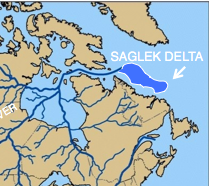East of the Andes is really dry, excepting the Amazon which is Tropical, and Patagonia which is Maritime. West of the Andes is humid besides maybe a small strip of far southern Chile which may host some dry valleys. Overall plenty of opportunities for irrigated civilizations to develop, I can see Wari and Tiwanaku-like highland cultures still forming in the Andes, then spreading down to the tropical humid and later to the temperate humid coast. In the east there are plenty of opportunities for Moche-like civilizations to form: Rio de la Plata, Brazilian Highlands, or even the Orinoco are much drier and suitable for agricultural civilizations. Even the Amazon Delta seems to be drier, and in OTL a fairly populous and complex culture, the Marijoara did form there, so maybe you can have them take a similar niche, but advancing further along the lines of how the desert-coast societies of Peru developed.
Yeah the study as well as Wayan’s Turnovia suggested that southern Chile is cooler and drier than our own, whereas both northern Chile (including to a lesser extent Santiago itself) and Patagonia (Inc the Falklands) are warmer and much wetter, with northern Chile in particular having Equadorian humidity and a definitely warmer climate year round. Peru is wetter in both the highlands and lowlands, especially the latter, so as Wayan predicted, it would definitely be able to sustain a larger population than otl, and ittl it would not be blocked off in latitude due to a drier and more open Equador in the north and a fertile northern Chile in the south, with the Atacama ironically being a breadbasket here. As mentioned in one of my updates, the Galápagos Islands are significantly warmer and wetter than our own. This greener Peru and northern Chile, known as Xiphito in my timeline, would certainly be a major regional power and would likely avoid foreign conquest by eurasians i
A wetter and maritime Patagonia could also be a nice settler colony for any power from across the Atlantic, so it is possible that some equivalent of colonisation occurs in these americas, though the emphasis is different, and mostly not from Europeans. Indeed the good majority of TTL’s Eurasian population is concentrated across North Africa and Southern Asia, so that would be the more likely source of any invaders.
I like the ideas shown for Brazilian zones and peoples, these could certainly bring the region up to speed and help avoid being just stomped by west Africans arriving. The very large desert in southern Brazil and northern Argentina is obviously a big issue to habitability, but populations converging around smaller fertile zones could encourage development more. As you said, a somewhat similar position exists in ittl’s Congo, as it is wetter around the coast but somewhat drier inland, if still pretty wet, resulting in more savannah.
As for North America, as mentioned on the thread itself, the Midwest and centre has hotter summers but similar winters to otl, like Central Asia, and along with the drier climate likely results in a steppe climate, meaning a much larger and hotter Great Plains, that includes part of our Great Lakes (due to the east American ice cap during the ice age being smaller in this timeline due to milder winters and less rainfall). New England’s drier, warmer and less seasonal climate results in a Mediterranean biome now being found here, akin to otl Portugal for example. Newfoundland and Quebec are slightly drier and wetter respectively with milder winters, so it’s possible Canada would be more populous ittl, at least in the east. As mentioned before, Cascadia is mostly drier and more seasonal and continental than otl, whereas southern California, Baja and Sonora are warmer and much wetter, as are to a lesser extent, NoCal, Utah, Nevada, New Mexico and Chihuahua. Ittl, the much wetter California and easlink with Oregon can easily allow larger and more elaborate societies to form around the coast, just as with Peru, but with SoCal and Baja having an irl Florida like climate. Very little difference in either department in the Midwest proper.
A huge difference in the south and southeast of course, with Louisiana having average July temperatures well over 40C, akin to the hottest parts of otl Sahara and similar in humidity. Texas is
even hotter and drier than our own, so not the most massive difference. Florida is relatively mild compared to the rest of the south, comparable to our Baja. The much hotter southern US is a far cry from our timeline, and that the heartland of otl Confederacy has a comparable climate to the Western Sahara (and vice versa here) is an amusing irony.
Most of the rest of Mexico is warmer and at least somewhat drier, with Mediterranean biome being present in much of the centre, while Yucatan is a desert or near it. Some of the maps have portrayed Central America as a desert in this timeline, though as mentioned due to the currents and actual humidity patterns, it probably isn’t as extreme as this for the most part, though it is certainly much drier than our own, along with most of the Carribbean. In fact there appears to have been a rough swap between the Caribbean islands and those of west Africa here in climate terms, with the former being cooler and drier than ours, whereas the Azores, Canaries and Verde are warmer and much wetter, as is Socotra on the other side of Africa.
Is there anything you think I missed or need to elaborate on?
